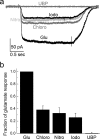Role of conformational dynamics in α-amino-3-hydroxy-5-methylisoxazole-4-propionic acid (AMPA) receptor partial agonism
- PMID: 23115239
- PMCID: PMC3527942
- DOI: 10.1074/jbc.M112.371815
Role of conformational dynamics in α-amino-3-hydroxy-5-methylisoxazole-4-propionic acid (AMPA) receptor partial agonism
Abstract
We have investigated the range of cleft closure conformational states that the agonist-binding domains of the α-amino-3-hydroxy-5-methylisoxazole-4-propionic acid (AMPA) receptors occupy when bound to a series of willardiine derivatives using single-molecule FRET. These studies show that the agonist-binding domain exhibits varying degrees of dynamics when bound to the different willardiines with differing efficacies. The chlorowillardiine- and nitrowillardiine-bound form of the agonist-binding domain probes a narrower range of cleft closure states relative to the iodowillardiine bound form of the protein, with the antagonist (αS)-α-amino-3-[(4-carboxyphenyl)methyl]-3,4-dihydro-2,4-dioxo-1(2H)-pyrimidinepropanoic acid (UBP-282)-bound form exhibiting the widest range of cleft closure states. Additionally, the average cleft closure follows the order UBP-282 > iodowillardiine > chlorowillardiine > nitrowillardiine-bound forms of agonist-binding domain. These single-molecule FRET data, along with our previously reported data for the glutamate-bound forms of wild type and T686S mutant proteins, show that the mean currents under nondesensitizing conditions can be directly correlated to the fraction of the agonist-binding domains in the "closed" cleft conformation. These results indicate that channel opening in the AMPA receptors is controlled by both the ability of the agonist to induce cleft closure and the dynamics of the agonist-binding domain when bound to the agonist.
Figures





Similar articles
-
Chemical interplay in the mechanism of partial agonist activation in alpha-amino-3-hydroxy-5-methyl-4-isoxazolepropionic acid receptors.Biochemistry. 2008 Jan 8;47(1):398-404. doi: 10.1021/bi702004b. Epub 2007 Dec 15. Biochemistry. 2008. PMID: 18081322 Free PMC article.
-
Allosteric mechanism in AMPA receptors: a FRET-based investigation of conformational changes.Proc Natl Acad Sci U S A. 2006 Jul 5;103(27):10473-10478. doi: 10.1073/pnas.0603225103. Epub 2006 Jun 22. Proc Natl Acad Sci U S A. 2006. PMID: 16793923 Free PMC article.
-
Tuning activation of the AMPA-sensitive GluR2 ion channel by genetic adjustment of agonist-induced conformational changes.Proc Natl Acad Sci U S A. 2003 May 13;100(10):5736-41. doi: 10.1073/pnas.1037393100. Epub 2003 May 2. Proc Natl Acad Sci U S A. 2003. PMID: 12730367 Free PMC article.
-
Partial agonism in heteromeric GLUK2/GLUK5 kainate receptor.Proteins. 2025 Jan;93(1):134-144. doi: 10.1002/prot.26565. Epub 2023 Aug 1. Proteins. 2025. PMID: 37526035 Free PMC article.
-
The regulation of AMPA receptor-binding sites.Mol Neurobiol. 1998 Winter;17(1-3):33-58. doi: 10.1007/BF02802023. Mol Neurobiol. 1998. PMID: 9887445 Review.
Cited by
-
Structure of the Arabidopsis Glutamate Receptor-like Channel GLR3.2 Ligand-Binding Domain.Structure. 2021 Feb 4;29(2):161-169.e4. doi: 10.1016/j.str.2020.09.006. Epub 2020 Oct 6. Structure. 2021. PMID: 33027636 Free PMC article.
-
Stargazin promotes closure of the AMPA receptor ligand-binding domain.J Gen Physiol. 2014 Dec;144(6):503-12. doi: 10.1085/jgp.201411287. J Gen Physiol. 2014. PMID: 25422502 Free PMC article.
-
Structural dynamics of the glycine-binding domain of the N-methyl-D-aspartate receptor.J Biol Chem. 2015 Jan 9;290(2):797-804. doi: 10.1074/jbc.M114.605436. Epub 2014 Nov 17. J Biol Chem. 2015. PMID: 25404733 Free PMC article.
-
Phosphorylation Induces Conformational Rigidity at the C-Terminal Domain of AMPA Receptors.J Phys Chem B. 2019 Jan 10;123(1):130-137. doi: 10.1021/acs.jpcb.8b10749. Epub 2018 Dec 27. J Phys Chem B. 2019. PMID: 30537817 Free PMC article.
-
Mechanism of modulation of AMPA receptors by TARP-γ8.J Gen Physiol. 2020 Jan 6;152(1):e201912451. doi: 10.1085/jgp.201912451. J Gen Physiol. 2020. PMID: 31748249 Free PMC article.
References
-
- Nakanishi S. (1992) Molecular diversity of glutamate receptors and implications for brain function. Science 258, 597–603 - PubMed
-
- Nakanishi S., Masu M. (1994) Molecular diversity and functions of glutamate receptors. Annu. Rev. Biophys. Biomol. Struct. 23, 319–348 - PubMed
-
- Madden D. R. (2002) The structure and function of glutamate receptor ion channels. Nat. Rev. Neurosci. 3, 91–101 - PubMed
-
- McFeeters R. L., Oswald R. E. (2004) Emerging structural explanations of ionotropic glutamate receptor function. FASEB J. 18, 428–438 - PubMed
-
- Valentine E. R., Palmer A. G., 3rd. (2005) Microsecond-to-millisecond conformational dynamics demarcate the GluR2 glutamate receptor bound to agonists glutamate, quisqualate, and AMPA. Biochemistry 44, 3410–3417 - PubMed
Publication types
MeSH terms
Substances
Grants and funding
LinkOut - more resources
Full Text Sources

